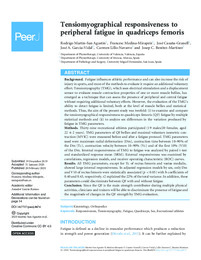Please use this identifier to cite or link to this item:
https://hdl.handle.net/11000/37945Full metadata record
| DC Field | Value | Language |
|---|---|---|
| dc.contributor.author | Martín San Agustín, Rodrigo | - |
| dc.contributor.author | Medina-Mirapeix, Francesc | - |
| dc.contributor.author | Casaña Granell, Jose | - |
| dc.contributor.author | García Vidal, José Antonio | - |
| dc.contributor.author | Lillo-Navarro, Carmen | - |
| dc.contributor.author | Benitez-Martinez, Josep C. | - |
| dc.contributor.other | Departamentos de la UMH::Patología y Cirugía | es_ES |
| dc.date.accessioned | 2025-11-07T09:08:38Z | - |
| dc.date.available | 2025-11-07T09:08:38Z | - |
| dc.date.created | 2020-02 | - |
| dc.identifier.citation | PeerJ. 2020 Feb 28:8:e8674 | es_ES |
| dc.identifier.issn | 2167-8359 | - |
| dc.identifier.uri | https://hdl.handle.net/11000/37945 | - |
| dc.description.abstract | Background. Fatigue influences athletic performance and can also increase the risk of injury in sports, and most of the methods to evaluate it require an additional voluntary effort. Tensiomyography (TMG), which uses electrical stimulation and a displacement sensor to evaluate muscle contraction properties of one or more muscle bellies, has emerged as a technique that can assess the presence of peripheral and central fatigue without requiring additional voluntary efforts. However, the evaluation of the TMG's ability to detect fatigue is limited, both at the level of muscle bellies and statistical methods. Thus, the aim of the present study was twofold: (i) to examine and compare the tensiomyographical responsiveness to quadriceps femoris (QF) fatigue by multiple statistical methods and (ii) to analyze sex differences in the variation produced by fatigue in TMG parameters. Methods. Thirty-nine recreational athletes participated (19 males/20 females; aged 22 2 years). TMG parameters of QF bellies and maximal voluntary isometric contraction (MVIC) were measured before and after a fatigue protocol. TMG parameters used were maximum radial deformation (Dm), contraction time between 10 90% of the Dm (Tc), contraction velocity between 10 90% (Vc) and of the first 10% (V10) of the Dm. Internal responsiveness of TMG to fatigue was analyzed by paired t-test and standardized response mean (SRM). External responsiveness was examined by correlations, regression models, and receiver operating characteristic (ROC) curves. Results. All TMG parameters, except for Tc of rectus femoris and vastus medialis, showed large internal responsiveness. In adjusted regression models by sex, only Dm and V10 of rectus femoris were statistically associated (p<0:05) with b coefficients of 0.40 and 0.43, respectively. r2 explained the 22% of the total variance. In addition, these parameters could discriminate between QF with and without fatigue. Conclusion. Since the QF is the main strength contributor during multiple physical activities, clinicians and trainers will be able to discriminate the presence of fatigue and the magnitude of changes in the QF strength by TMG evaluation. | es_ES |
| dc.format | application/pdf | es_ES |
| dc.format.extent | 19 | es_ES |
| dc.language.iso | eng | es_ES |
| dc.publisher | PeerJ | es_ES |
| dc.rights | info:eu-repo/semantics/openAccess | es_ES |
| dc.rights | Attribution-NonCommercial-NoDerivatives 4.0 Internacional | * |
| dc.rights.uri | http://creativecommons.org/licenses/by-nc-nd/4.0/ | * |
| dc.subject | Responsiveness | es_ES |
| dc.subject | Tensiomyography | es_ES |
| dc.subject | Fatigue | es_ES |
| dc.subject | Quadriceps | es_ES |
| dc.subject | Sex | es_ES |
| dc.subject | Recreational athletes | es_ES |
| dc.subject.other | CDU::6 - Ciencias aplicadas::61 - Medicina | es_ES |
| dc.title | Tensiomyographical responsiveness to peripheral fatigue in quadriceps femoris | es_ES |
| dc.type | info:eu-repo/semantics/article | es_ES |
| dc.relation.publisherversion | https://doi.org/10.7717/peerj.8674 | es_ES |

View/Open:
Tensiomyographical responsiveness to peripheral fatigue in quadriceps femoris.pdf
3,17 MB
Adobe PDF
Share:
.png)
